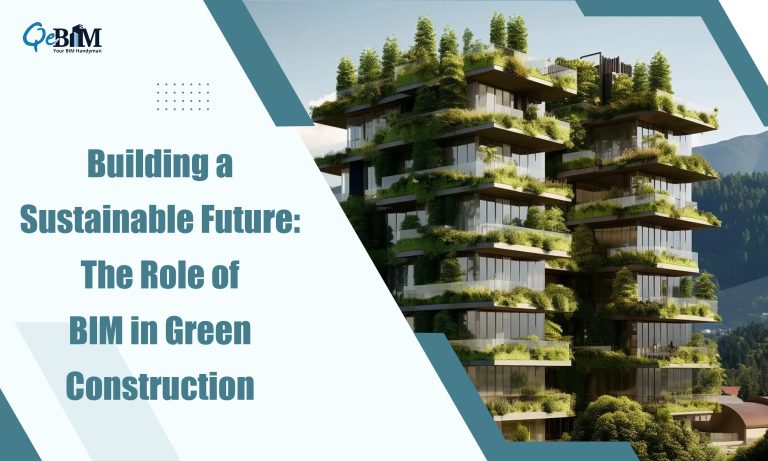Building a Sustainable Future: The Role of BIM in Green Construction

Introduction:
Considering the scenario of architecture and construction industry, the pursuit of sustainable building practices has become a paramount goal. As the global community grapples with the climatic change challenges, the construction industry has a crucial role to play in mitigating its environmental footprint. Building Information Modelling (BIM) has emerged as a powerful tool in achieving sustainable building goals, offering innovative solutions that enhance efficiency, reduce waste, and promote environmentally conscious decision-making.
Understanding BIM:
BIM is a digital illustration of the physical as well as functional characteristics of any building or infrastructure. It goes beyond traditional 2D blueprints by incorporating three-dimensional models with comprehensive data about each element in the structure. By adopting a data-centric approach, stakeholders can effortlessly collaborate throughout every stage of a project’s lifecycle, spanning from design and construction to operation and maintenance.
Energy Efficiency through Simulation:
One of the key contributions of BIM to sustainable building practices is its ability to simulate and optimize energy performance. BIM software enables architects and engineers to create virtual prototypes of buildings, analyzing factors such as solar exposure, ventilation, and thermal performance. Through the simulation of diverse scenarios, professionals can make well-informed decisions that significantly improve energy efficiency, reducing the overall environmental footprint of a structure.
Material Selection and Lifecycle Assessment:
Sustainable construction involves making environmentally conscious choices in material selection and usage. BIM Outsourcing Services facilitates a holistic approach by providing a platform for detailed material analysis and lifecycle assessment. Professionals can evaluate the environmental impact of different materials, considering factors like extraction, manufacturing, transportation, and disposal. This informed decision-making process ensures that construction projects align with sustainability goals, minimizing resource depletion and waste generation.
Collaborative Decision-Making:
BIM promotes collaboration among various stakeholders, fostering a more integrated and efficient construction process. Architects, engineers, contractors, and other project contributors can work together in real-time on a centralized platform. This collaborative approach enables better decision-making, reduces errors, and streamlines the construction process, ultimately leading to more sustainable outcomes.
Waste Reduction and Prefabrication:
Construction projects are well-known for producing substantial volumes of waste.BIM helps address this issue by optimizing construction processes and promoting prefabrication. Through detailed planning and visualization, BIM allows for the creation of modular components that can be prefabricated off-site. This not only reduces on-site waste but also enhances construction efficiency, resulting in lower energy consumption and a smaller ecological footprint.
Optimized Facility Management:
Sustainability doesn’t end with the completion of construction; it extends to the ongoing operation and maintenance of buildings. BIM extends its functionalities beyond the construction stage, offering valuable data for effective facility management.This includes real-time monitoring of energy usage, predictive maintenance, and the ability to optimize building systems for continued efficiency. By leveraging BIM for facility management, building owners can ensure that their structures operate at peak sustainability throughout their lifespan.
Regulatory Compliance and Certification:
Sustainable construction often involves adherence to specific environmental standards and certifications. BIM facilitates compliance with these regulations by providing a platform for accurate documentation and reporting. Professionals can track and manage various sustainability metrics, ensuring that construction projects meet the necessary criteria for certification. This not only enhances the credibility of the project but also contributes to the broader goal of promoting sustainable building practices using accurate Energy-Efficiency Services on a global scale.
Case Studies:
Several successful projects showcase the transformative impact of BIM on sustainable construction. The Edge, a high-tech office building located in Amsterdam, utilized BIM to achieve exceptional energy efficiency and sustainability. By leveraging BIM’s capabilities for energy simulation, the design team optimized the building’s orientation and materials, resulting in a highly efficient and eco-friendly workspace.
Conclusion:
As the construction industry strives to build a greener future, BIM stands out as a catalyst for change. Its ability to enhance collaboration, optimize energy efficiency, and streamline sustainable practices positions BIM as an invaluable tool in the pursuit of environmentally conscious construction. By embracing BIM, stakeholders can not only meet current sustainability goals but also pave the way for a more ecologically responsible and resilient built environment for future generations.